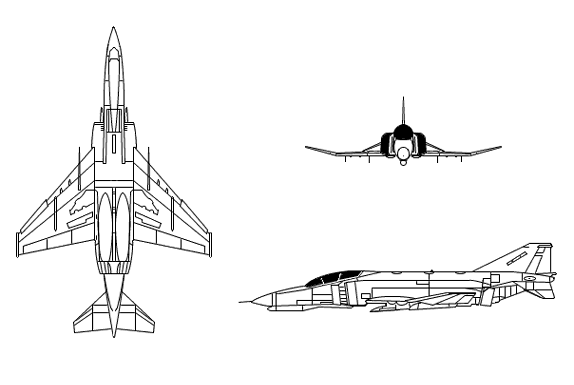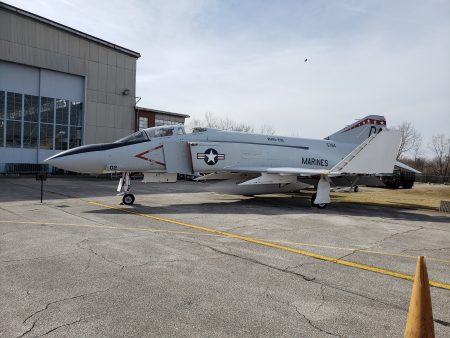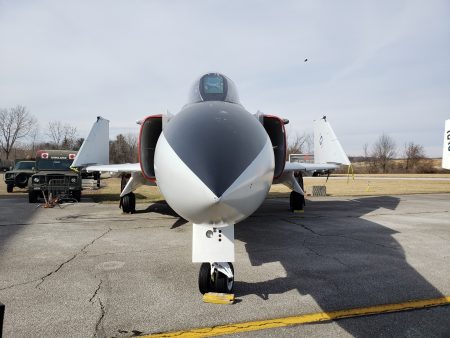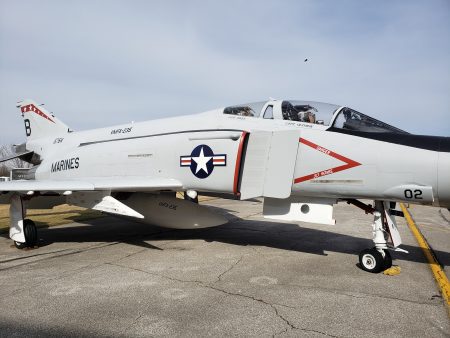Our Aircraft’s History
McDonnell Douglas F-4S “Phantom II” (Bureau #155764; MSN #2980) ~ The Phantom that resides at MAPS was originally built as a F-4J-34-MC “Phantom” at the McDonnell-Douglas Aircraft in St. Louis, Missouri in July 1968 and accepted by the US Navy on July 29, 1968. She was first assigned to Fighter Squadron (VF)-21, NAS, Mirimar, California that same month.
The Phantom was the first aircraft to be used concurrently by the US Navy, Air Force and Marines Corp.. The Phantom II was designed as an all-weather, long-range supersonic jet interceptor and fighter/bomber and was the principal fighter for the US military during the Vietnam War.
Our F-4J entered service right in the middle of the Vietnam conflict and served in multiple places, including, but not limited to:
- July 1970 – USS Enterprise (Western Pacific/Vietnam/Indian Ocean Area of Operations)
- October 1971 – Fleet Air West Pacific Repair Facility, Atsugi, Japan
- December 1974 – USS Kitty Hawk (Western Pacific/Vietnam/Indian Ocean Area of Operations)
- December 1975 – Marine Fighter Attack Squadron (VMFA)-251, Beaufort, South Carolina
- August 1977 & July 1978 – USS Saratoga (Mediterranean)
- January 1979 – USS Forrestal (Mediterranean)
- September 1982 – Naval Aircraft Rework/Refit Facility (NARF), North Island, California where she was converted to the present day F-4S
- June 1983 – VMFA-251, Beaufort, California, then to MCAS Cherry Point, North Carolina, then Trondheim, Norway and Nellis Air Force Base, Nevada
- March 1988 – VMFA-235, MCAS Kaneohe Bay, Hawaii
On April 22, 1989, this Phantom was withdrawn from service and was scheduled to become part of the Navy Drone program. However, the drone program was cancelled in January 2003 and the aircraft was dropped from the Navy inventory. In November of 2003, she was delivered to MAPS Air Museum for restoration and display. Crew Chief Ken Olinger maintains the Phantom II while at MAPS.
Specifications/Performance
- Role: Interceptor, fighter/bomber

- Crew: 2
- Manufacturer: McDonnell Aircraft Corporation/McDonnell Douglas
- First flight: May 27, 1958
- Introduction: December 30, 1960
- Retired: 1996 (US)
- Produced: 1958-1981
- Built: 5,195
- Unit cost: $2.4 million (1965 F-4E)
- Length: 58 ft 3 in
- Wingspan: 38 ft 5 in
- Height: 16 ft 5 in
- Empty weight: 30,328 lb
- Max takeoff weight: 61,795 lb
- Engines: 2 x General Electric J79-GE-17A after-burning turbojet engines, 11,905 lbf each (17,845 lb w/ afterburner)
- Max speed: 1,470 mph at 40,000 ft (Mach 2.23)
- Cruise speed: 580 mph
- Combat range: 420 mph
- Ferry range: 1,677 mi
- Service ceiling: 60,000 ft
Armament, notable:
- 20 mm M61A1 Vulcan cannon (640 rounds) on E-model
- Up to 18,650 lbs of weapons, combinations of:
- 4 x AIM-9 Sidewinders
- 4 x AIM-7 Sparrow or upgraded AIM-120 AMRAAM
- 6 x AGM-65 Maverick
- 4 x AGM-62 Walleye
- 4 x AGM-45 Shrike, AGM-88 HARM or AGM-78 Standard ARM
- 4 x GBU-15
- 18 x Mk.82, GBU-12
- 5 x Mk.84, GBU-10, GBU-14
- 18 x CBU-87, CBU-89, CBU-58
- Nuclear weaspons, including B28EX, B61, B43 and B57
Museum display note: our F4-S “Phantom II” is painted and marked as an F4-J with the VF-21 Freelancers during its time with the US Navy on the USS Ranger in the late 1960’s. The aircraft is graciously on indefinite loan from the National Naval Aviation Museum, Pensacola, Florida.
Designed to replace: F3H Demon (US Navy)
Intended replacement: F-15 Eagle & F-16 Fighting Falcon (US Air Force); F-14 Tomcat (US Navy); F/A-18 Hornet (US Navy & US Marines Corp)




